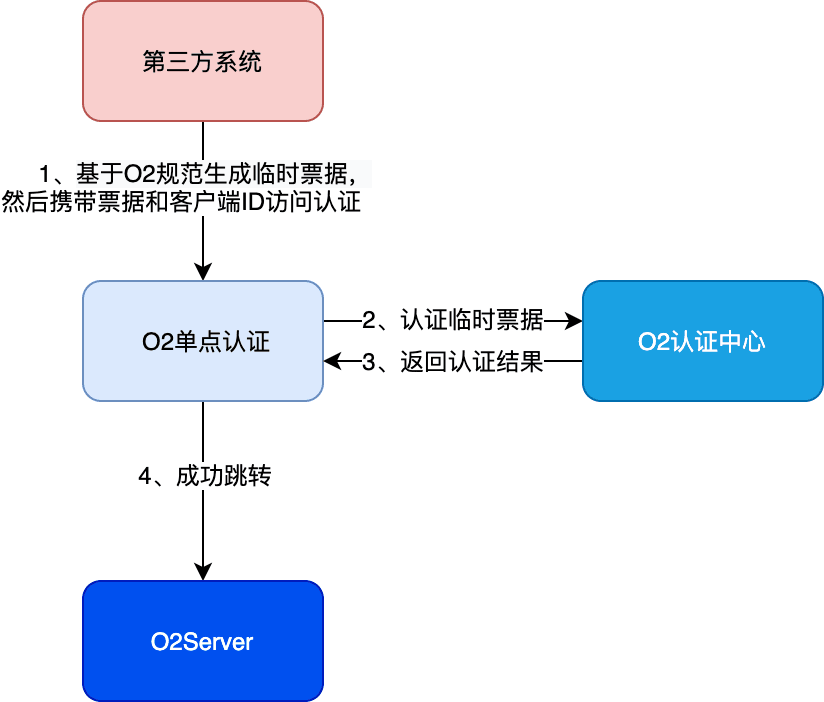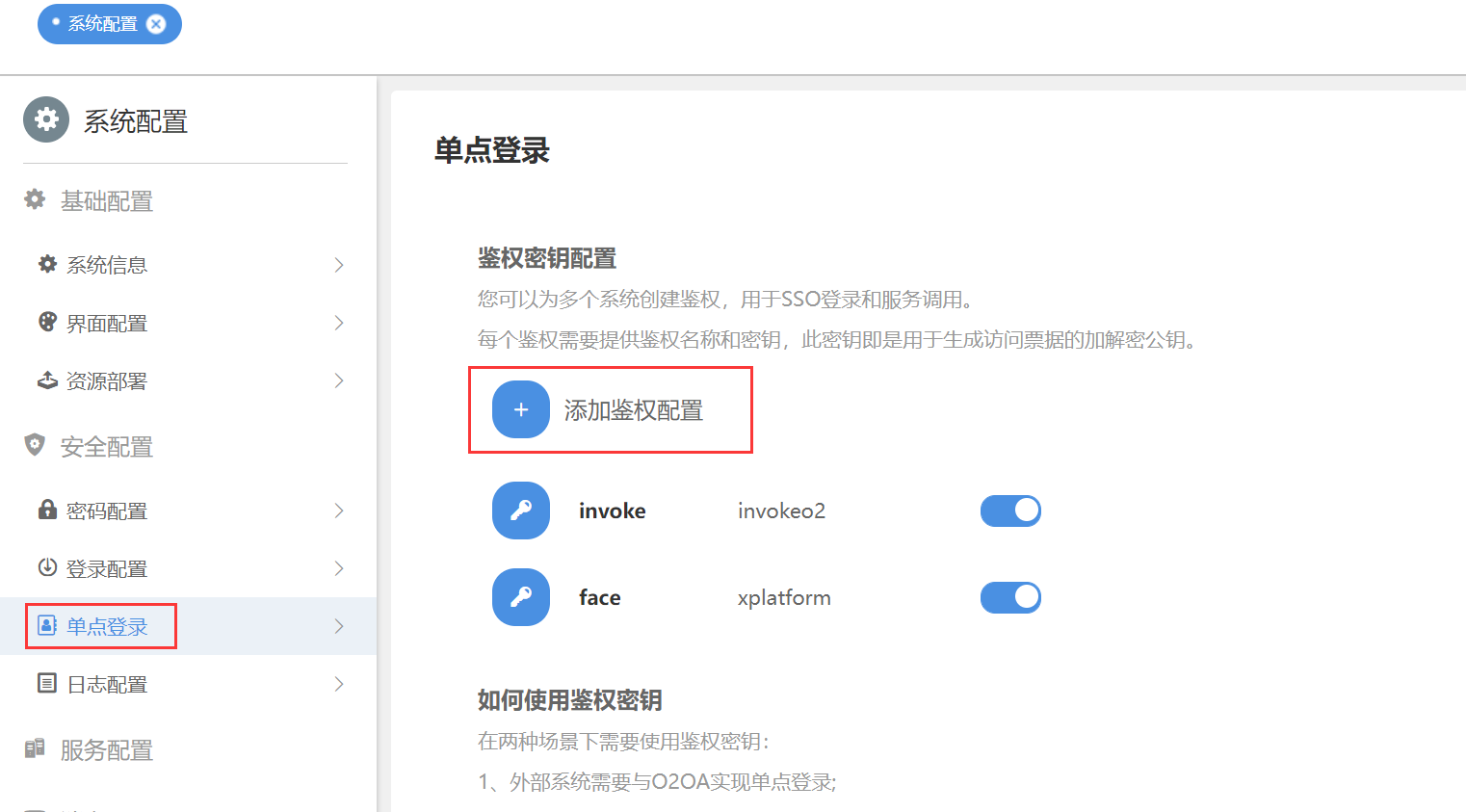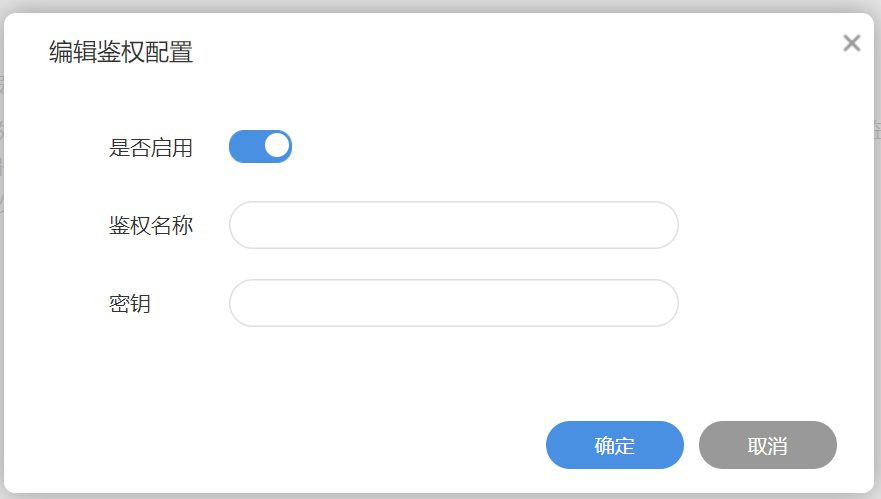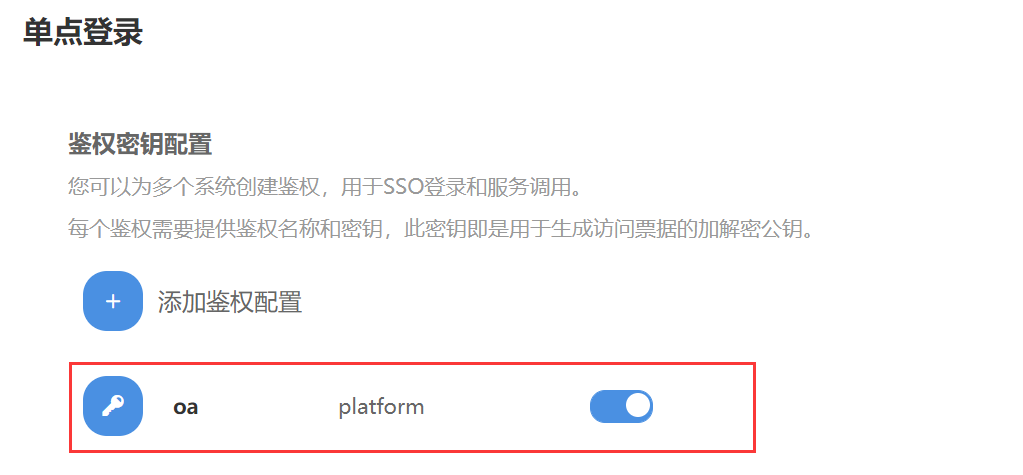使用鉴权配置实现外部系统与O2OA平台的单点登录
单点登录(Single Sign On),简称为 SSO,定义是在多个应用系统中,用户只需要登录一次就可以访问所有相互信任的应用系统。
O2OA系统默认提供两种单点登陆解决方案:加密认证方式和OAuth2认证方式。本文主要介绍加密认证方式。有关OAuth2认证方式请查看:https://www.o2oa.net/cms/tech/102.html
加密认证方式
加密认证方案是第三方系统通过生成加密的临时票据,然后使用这个临时票据进行单点认证。

创建鉴权密钥
要产生认证临时票据,我们需要先在O2OA平台创建一个鉴权密钥配置。
具有管理员权限的用户(具有Manager角色),打开“系统设置”-“安全配置”-“单点登录”,找到“鉴权密钥配置”。

点击“添加鉴权配置”:

此处需要配置一个名称和密钥。
名称:可随意填写,就是我们在调用接口或进行SSO时要传入的client参数。
密钥:可随意填写,用于后续加密,最少8位。
此处我们假设名称填写:oa;密钥填写:platform
填写完成后确定。
然后我们就可以使用此鉴权配置来实现单点登录了。
生成临时票据token
将创建好的鉴权名称和鉴权密钥告知外部系统,由外部系统生成与O2OA单点认证的临时票据。
外部系统必须先生成临时票据(token),这个token是采取DES算法使用密钥对"person#timestamp"文本进行加密获取的。其中:
person:表示指定用户的用户名、唯一编码或员工号。(具体使用哪个要根据外部系统与O2OA的用户关联的字段)
timestamp:表示为1970年1月1日0时0秒到当前时间的毫秒数。(token的有效时间为1分钟)
下面提供一些加密的样例代码:
javascript加密代码样例
我们使用CryptoJS进行DES加密。(GitHub: https://github.com/brix/crypto-js)
样例:
var login_uid = "test"; var time = new Date().getTime(); var sso_key = "12345678"; var xtoken = crypDES( login_uid + "#" + time, sso_key );
IOS加密代码样例
/// o2oa DES加密 @param publicKey 加密公钥
func o2DESEncode(code: String, publicKey: String) -> String? {
if let encode = desEncrypt(code: code, key: publicKey, iv: "12345678", options: (kCCOptionECBMode + kCCOptionPKCS7Padding)) {
let first = encode.replacingOccurrences(of: "+", with: "-")
let second = first.replacingOccurrences(of: "/", with: "_")
let token = second.replacingOccurrences(of: "=", with: "")
return token
}else {
print("加密错误")
return nil
}
}
/// DES 加密
func desEncrypt(code: String, key:String, iv:String, options:Int = kCCOptionPKCS7Padding) -> String? {
if let keyData = key.data(using: String.Encoding.utf8),
let data = code.data(using: String.Encoding.utf8),
let cryptData = NSMutableData(length: Int((data.count)) + kCCBlockSizeDES) {
let keyLength = size_t(kCCKeySizeDES)
let operation: CCOperation = UInt32(kCCEncrypt)
let algoritm: CCAlgorithm = UInt32(kCCAlgorithmDES)
let options: CCOptions = UInt32(options)
var numBytesEncrypted :size_t = 0
let cryptStatus = CCCrypt(operation,
algoritm,
options,
(keyData as NSData).bytes, keyLength,
iv,
(data as NSData).bytes, data.count,
cryptData.mutableBytes, cryptData.length,
&numBytesEncrypted)
if UInt32(cryptStatus) == UInt32(kCCSuccess) {
cryptData.length = Int(numBytesEncrypted)
let base64cryptString = cryptData.base64EncodedString()
return base64cryptString
}
else {
return nil
}
}
return nil
}样例:
let uid = "test" let timeInterval = Date().timeIntervalSince1970 let time = CLongLong(round(timeInterval*1000)) let code = "(uid)#(time)" let xtoken = code.o2DESEncode() ?? ""
Android加密代码样例
fun o2DESEncode(code: String, publicKey: String): String {
val sutil = CryptDES.getInstance(publicKey)
var encode = ""
try {
encode = sutil.encryptBase64(code)
Log.d(LOG_TAG,"加密后code:$encode")
encode = encode.replace("+", "-")
encode = encode.replace("/", "_")
encode = encode.replace("=", "")
Log.d(LOG_TAG,"替换特殊字符后的code:$encode")
}catch (e: Exception) {
Log.e(LOG_TAG,"加密失败", e)
}
return encode
}
public class CryptDES {
private Cipher encryptCipher = null;
private Cipher decryptCipher = null;
private static CryptDES des = null;
public static CryptDES getInstance(String des_key) {
try {
DESKeySpec key = new DESKeySpec(des_key.getBytes());
SecretKeyFactory keyFactory = SecretKeyFactory.getInstance("DES");
des = new CryptDES(keyFactory.generateSecret(key));
} catch (Exception e) {
e.printStackTrace();
}
return des;
}
private CryptDES(SecretKey key) throws Exception {
encryptCipher = Cipher.getInstance("DES");
decryptCipher = Cipher.getInstance("DES");
encryptCipher.init(Cipher.ENCRYPT_MODE, key);
decryptCipher.init(Cipher.DECRYPT_MODE, key);
}
public String encryptBase64 (String unencryptedString) throws Exception {
// Encode the string into bytes using utf-8
byte[] unencryptedByteArray = unencryptedString.getBytes("UTF8");
// Encrypt
byte[] encryptedBytes = encryptCipher.doFinal(unencryptedByteArray);
// Encode bytes to base64 to get a string
byte [] encodedBytes = Base64.encode(encryptedBytes, Base64.DEFAULT);
return new String(encodedBytes);
}
public String decryptBase64 (String encryptedString) throws Exception {
// Encode bytes to base64 to get a string
byte [] decodedBytes = Base64.encode(encryptedString.getBytes(), Base64.DEFAULT);
// Decrypt
byte[] unencryptedByteArray = decryptCipher.doFinal(decodedBytes);
// Decode using utf-8
return new String(unencryptedByteArray, "UTF8");
}
}Java加密代码样例
Crypto.java
import java.io.IOException;
import java.net.URLDecoder;
import java.net.URLEncoder;
import java.security.SecureRandom;
import javax.crypto.Cipher;
import javax.crypto.SecretKey;
import javax.crypto.SecretKeyFactory;
import javax.crypto.spec.DESKeySpec;
import org.apache.commons.codec.binary.Base64;
import org.apache.commons.lang3.StringUtils;
/**
* encrypt and decrypt utils
* @author O2OA
*
*/
public class Crypto {
private static final String utf8 = "UTF-8";
private final static String DES = "DES";
private final static String cipher_init = "DES";
public static String encrypt(String data, String key) throws Exception {
byte[] bt = encrypt(data.getBytes(), key.getBytes());
String str = Base64.encodeBase64URLSafeString(bt);
return URLEncoder.encode( str, utf8 );
}
public static byte[] encrypt(byte[] data, byte[] key) throws Exception {
// 生成一个可信任的随机数源
SecureRandom sr = new SecureRandom();
// 从原始密钥数据创建DESKeySpec对象
DESKeySpec dks = new DESKeySpec(key);
// 创建一个密钥工厂,然后用它把DESKeySpec转换成SecretKey对象
SecretKeyFactory keyFactory = SecretKeyFactory.getInstance(DES);
SecretKey securekey = keyFactory.generateSecret(dks);
// Cipher对象实际完成加密操作
Cipher cipher = Cipher.getInstance(cipher_init);
// 用密钥初始化Cipher对象
cipher.init(Cipher.ENCRYPT_MODE, securekey, sr);
return cipher.doFinal(data);
}
public static String decrypt(String data, String key) throws IOException, Exception {
if (StringUtils.isEmpty(data)) {
return null;
}
String str = URLDecoder.decode(data, utf8);
byte[] buf = Base64.decodeBase64(str);
byte[] bt = decrypt(buf, key.getBytes());
return new String(bt);
}
public static byte[] decrypt(byte[] data, byte[] key) throws Exception {
// 生成一个可信任的随机数源
SecureRandom sr = new SecureRandom();
// 从原始密钥数据创建DESKeySpec对象
DESKeySpec dks = new DESKeySpec(key);
// 创建一个密钥工厂,然后用它把DESKeySpec转换成SecretKey对象
SecretKeyFactory keyFactory = SecretKeyFactory.getInstance(DES);
SecretKey securekey = keyFactory.generateSecret(dks);
// Cipher对象实际完成解密操作
Cipher cipher = Cipher.getInstance(cipher_init);
// 用密钥初始化Cipher对象
cipher.init(Cipher.DECRYPT_MODE, securekey, sr);
return cipher.doFinal(data);
}
}调用:
String login_uid = "test"; long time = new Date().getTime(); String sso_key = "12345678"; String xtoken = Crypto.encrypt( login_uid + "#" + time, sso_key );
实现单点登录
生成token后,外部系统可以直接通过访问以下地址,实现与O2OA的单点认证:
http://servername/x_desktop/sso.html?client={client}&xtoken={token}&redirect={redirect}
其中的client表示使用的鉴权名称;
token表示产生的临时票据token;
redirect表示认证成功后要跳转到的地址;
当然也可以通过访问下面的接口服务,来获取O2OA平台的登录session:
getLogin: x_organization_assemble_authentication 下的SsoAction中的getLogin方法
postLogin: x_organization_assemble_authentication 下的SsoAction中的postLogin方法


 浙公网安备 33010602009829号
浙公网安备 33010602009829号